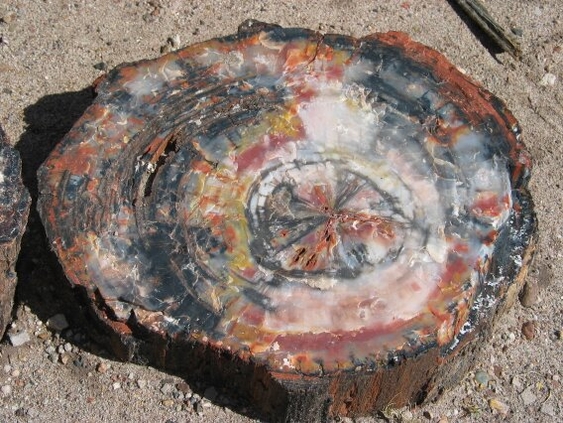 |
 |
 |
 |
 |
 |
 |
 |
|
 |
 |
 |
51 Petroleum, coal and petrified wood
|
| Menu | back |
The claim that it requires long periods of time for the development of oil, coal or petrified wood is obsolete. Rapid formation of oil has already been tested experimentally for some time and in 2006 it was discovered that coal can form overnight under favourable conditions. Patents have already been registered for some years for petrifaction of wood. Petrified wood is used, for example, for tabletops and chimney plates.
Formation of coal:
An announcement by the Max-Planck Institute indicates that straw, wood, moist grass or leaves can be converted to coal overnight (1). A process has been presented with which plant biomass can be converted virtually completely to carbon and water directly without complicated intermediate steps. The process is called hydrothermal carbonization. It works like a steam pressure cooker, only at higher temperatures.
The cooking recipe for coal is amazingly simple. A pressure vessel is filled with any type of vegetable products, for example, with leaves, straw, grass, pieces of wood or pinecones. Then water and a small quantity of citric acid are added. The vessel is then sealed and the content is heated under pressure for twelve hours at 180 degrees Celsius. After the mixture has cooled down, the vessel is opened. It contains an aqueous black broth with finely distributed spherical-shaped particles of carbon called colloids. All carbon previously contained in the vegetable material is now in the form of these particles as small, porous lignite balls.
Rapid formation of coal in nature:
In the Triassic or Jurassic period, carbon strata developed within only twenty-five to thirty years. This is revealed by the oval and circular concentric polonium radiohalos present in the material. Polonium-210 has a half-life of 138.4 days. If the radiohalos developed before compression of the coal stratum, they all would have to be oval (2).
Formation of petroleum:
For formation of sediment basins and the petroleum reserves present therein, geoscientists assume protracted processes lasting millions of years. By contrast, hydropyrolyses laboratory experiments on bedrock from sediment basins showed that petroleum can be formed and extracted very quickly at appropriately high temperatures or under suitable catalytic conditions (3).
As reported by geologists Borys M. Didyk and Bernd R.T. Simoneit, a 500 m thick deposit of phytoplankton, freely suspended seaweed from which petroleum escapes (4), is present in the Guaymas basin in the Gulf of California. Hypothermal fluids with a diameter of 8-12 cm are present at the surface of these sediments from which hot water exits at a temperature of 200°C. This water carries small spheres of oil with a diameter of 1-2 cm with it. Detailed research has shown that the composition of this oil is very similar to common petroleum. Age measurements using the radiocarbon method indicated 4,200-4,900 years. The oil formed at a temperature of over 315°C at a pressure of 200 bars. The estimate of the quantity of oil formed showed that use of the oil would be worthwhile if it could be collected.
Petrification of wood:
|
 |
|
When wood is deposited in rivers, lakes or in the sea and is covered quickly enough with sediment, the conditions for petrification can result. The same phenomenon is caused by embedding the wood in volcanic ash and tuffite following a volcanic eruption. Without contact to the oxygen in the air, the wood constituents are leached out and replaced by minerals from the surrounding soil.
Polished slice of petrified wood |
American scientists have been successful in petrifying wood within a few days (5). During this process, the organic wooden material is replaced little by little by minerals for example, crystallized silica so that the original structure is preserved completely (6).
Cosmology and the big bang theory | Menu |
back
|
References:
|
| (1) |
Wissenschaftsmagazin MaxPlanckForschung, Edition 2/2006. |
| (2) |
Larry Vardiman, Andrew A. Snelling, Eugene F. Chaffin, Radioisotope und das Alter der Erde, Hänssler-Verlag, Holzgerlingen, 2004, pages 189227. |
| (3) |
Thomas Herzog, Schnelle Erdölbildung durch hydrothermale Prozesse Naturnahe Modellierung der Hydro-Pyrolyse und Beispiele aus der Lagerstättenkunde,Studium Integrale, April 2003, pages 2027, http://www.wort-und-wissen.de/index2.php?artikel=sij/sij101/sij101-3.html. |
| (4) |
Borys M. Didyk und Bernd R.T. Simoneit, Hydrothermal oil of Guaymas Basin and implications for petroleum formation mechanisms, Nature, Vol. 342, 2. November 1989, pages 6569. |
| (5) |
Yongsoon Shin et al., Pacific Northwest National Labors, Richland, Advanced Materials, Vol. 17, page 73. |
| (6) |
Hamilton Hicks, Mineralized sodium silicate solutions for artificial petrification of wood, US Patent Number 4,612,050, 16 Sept. 1986, pages 13. | |
| |
| (Image "Polished slice of petrified wood") http://en.wikipedia.org/wiki/Petrified_wood |
| |
Comment this Site!
|
 |
 |
 |
 |
|

